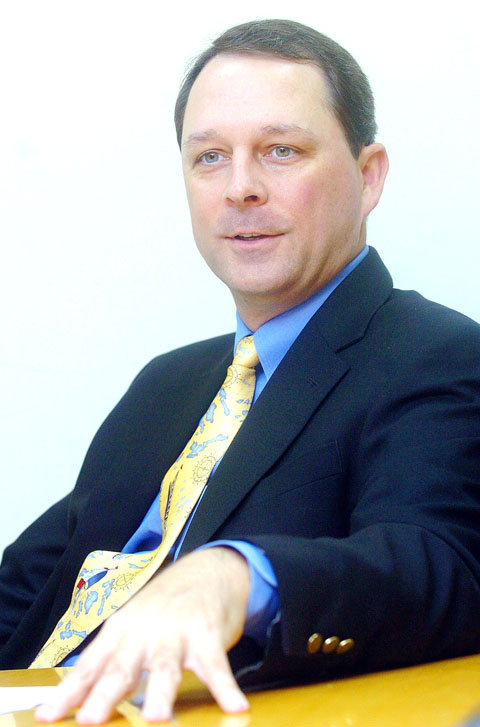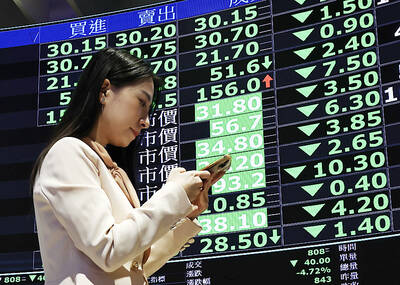Taipei Times (TT): Explain what a server is to the non-tech savvy readers out there.
Mark Wiltse: Servers help information to flow around the world. As more people get on the Internet, and more people communicate through Google and Yahoo, [these companies] need a lot of computer power. [These companies] have server farms, rolls and rolls of computers, multiples of them. As you surf on the Internet you want it to be pretty quick.

PHOTO: CHANG CHIA-MING, TAIPEI TIMES
TT: What are your goals and responsibilities as the director of Taiwan System and Technology Laboratory (TSTL)?
Wiltse: As director of the lab, and as the very visible face of IBM here in Taiwan from a development perspective, my job function mirrors more of a general manager’s role than a development director’s role.
[I am] general manager in the sense [that] I do have product delivery responsibility [and] external visibility responsibility. As a senior leader here interfacing to some of the other functions, I communicate regularly with other labs.
[For instance, there are many common building blocks among the labs]. If there’s a certain mechanical chassis between two or three product lines, we communicate frequently to make sure we’re all designing to the same mechanical chassis.
TT: What are your views on the research and development (R&D) environment in Taiwan? Can you contrast that to the environment in the US or in China?
Wiltse: There’s more similarity than differences from a worldwide perspective. Differences [lie only in] what technologies people have started to work on. Worldwide there are more similarities. Math is math. If you take that to an extreme, it’s engineering, it’s all the same. The logical thinking and the rigor is [all] the same.
TT: You mentioned previously that TSTL is “not merely a remake of the US experience.” Can you elaborate on that?
Wiltse: TSTL is not merely a remake of the US experience. We’re new; people have only been here [for] four years. Most of the labs in the US have been around for 30 to 35 years. They take on a certain mature personality; they have a lot of experts because we have been innovating for that long in those places.
First, TSTL is more of a partnership environment that our US colleagues, so that has generated an interesting development model. Secondly, being younger in general [makes a difference]— our average age [here] is a little bit younger. Thirdly, from a responsibility perspective, we are able to provide opportunities to people earlier in their careers. And, lastly, there’s a certain eagerness [at TSTL for engineers] to try things when you have fresh energy and fresh people.
TT: TSTL can be very discrete sometimes. Why is that?
Wiltse: We are secretive not to be evil, but because we are working on unannounced products. Many of those programs we are designing, we are trying to make better than our competitors. The more that I can keep hidden until I announce it, [the more] I can be in a better position.
TT: Who are your competitors? Do you look at each other’s products when designing your own?
Wiltse: Dell and HP are the big two for us. We watch them on multiple elements: cost, performance, design and ease of use. We do not copy them and they don’t copy us because each of these companies has a different focus from a customer perspective. We all have different personalities.
[At IBM] we offer innovation and high value to customers. This isn’t something our competitors are good at. They might be much better at low-cost design, for example. But that’s not what IBM is focused on. We’re trying to find the hard problems and solve them for our customers.
TT: Let’s talk a little about your collaboration with local companies.
Wiltse: Part of the reason we’re here is to partner up with the companies that are really experts at designing and developing the components for the computer. We’re excellent at system design. [With] the sub components [of our systems] throughout our history, we have allowed other companies to become the experts. And we began to utilize them.
So there are many companies here in Taiwan that we partner with in order to deliver products to our customers. Many of these are the same companies that Dell and HP partner with.
TT: How is TSTL helping local companies to transit from being original equipment manufacturers (OEM) to original design manufacturers (ODM)?
Wiltse: The evolution of local Taiwanese companies that we’re partnering with has been happening for over 15 years.
They started out being focused on manufacturing that expertise began to solidify, there were lower level design elements that became more efficient for them to do, rather than for us to do in the United States.
Over time, as Taiwanese company skills began to grow, we began to continue our education to try to move them to places higher up the skill set. That evolution has been happening and is expected to [continue] over the next 15 to 20 years.
These local companies began to change their thinking process of simply doing what they’re told to [do]. If I have my partners focused on innovation and contributing to invention, that expands the number of people making IBM products better and more innovative.
TT: What are IBM’s efforts toward green technology?
Wiltse: Saving energy has turned out to be something our customers are now demanding. If I can save 1, 2 or 3 watts a server, these [server farms save] real money. [Also] It goes beyond just computers because the less heat I put out, there’s more savings.
We have both won and lost based on power consumption. Although people like to talk about green, we’re pursuing green for a very basic business reason: Our customers are demanding it.
If we don’t pursue green, we’re not going to be competitive. So clearly, given our innovation and our expertise, that’s a key area [in which] we think we can be [a leader].
Today, if you look at the purchase price, the computer has been the smallest part of the expense of a computer. Operating cost, cooling cost, maintenance cost are significantly larger portions of total cost of ownership for computers.
TT: Due to the economic slowdown, are you witnessing diminished corporate spending on IT products?
Wiltse: It’s too early to tell. If you look at companies around the world that are well managed, they have long-term strategies. The best IBM customers, we have long-term relationships. I’m optimistic that our relationships are going to be maintained with our key customers. We’ll continue to talk to our customers and continue to develop the solution that they need.
TT: What are your thoughts on cloud computing?
Wiltse: It’s wonderful. If you take cloud computing as a concept, one of the building blocks of cloud computing is the iDataPlex. The concept of sharing IT resources without anyone being dedicated to one particular server. [This] really helps companies increase efficiency of computer usage. [Cloud computing means] to be able to use IT and infrastructure for multiple applications.
[If] you can extend that further where people can share, that [would] generate a little bit of nervousness if one company wants to share its IT resources with another company. We’re still working on that concept.
Parallel [cloud computing] with electricity. You don’t have a dedicated power plant. The electricity is just in the infrastructure. If computing power is part of the infrastructure, then it becomes more like a utility than anything else.
[In fact] computer technology is very, very evolutionary. Every once in a while we’ll come to a point where several technologies that have been evolving over a number of years come together in form. Now [as] there [is] some excitement, more people get in, more innovation applies, and [we are more] able to generate real solutions for customers.

TARIFFS: The global ‘panic atmosphere remains strong,’ and foreign investors have continued to sell their holdings since the start of the year, the Ministry of Finance said The government yesterday authorized the activation of its NT$500 billion (US$15.15 billion) National Stabilization Fund (NSF) to prop up the local stock market after two days of sharp falls in reaction to US President Donald Trump’s new import tariffs. The Ministry of Finance said in a statement after the market close that the steering committee of the fund had been given the go-ahead to intervene in the market to bolster Taiwanese shares in a time of crisis. The fund has been authorized to use its assets “to carry out market stabilization tasks as appropriate to maintain the stability of Taiwan’s

STEEP DECLINE: Yesterday’s drop was the third-steepest in its history, the steepest being Monday’s drop in the wake of the tariff announcement on Wednesday last week Taiwanese stocks continued their heavy sell-off yesterday, as concerns over US tariffs and unwinding of leveraged bets weighed on the market. The benchmark TAIEX plunged 1,068.19 points, or 5.79 percent, to 17,391.76, notching the biggest drop among Asian peers as it hit a 15-month low. The decline came even after the government on late Tuesday authorized the NT$500 billion (US$15.2 billion) National Stabilization Fund (國安基金) to step in to buoy the market amid investors’ worries over tariffs imposed by US President Donald Trump. Yesterday’s decline was the third-steepest in its history, trailing only the declines of 2,065.87 points on Monday and

TARIFF CONCERNS: The chipmaker cited global uncertainty from US tariffs and a weakening economic outlook, but said its Singapore expansion remains on track Vanguard International Semiconductor Corp (世界先進), a foundry service provider specializing in producing power management and display driver chips, yesterday withdrew its full-year revenue projection of moderate growth for this year, as escalating US tariff tensions raised uncertainty and concern about a potential economic recession. The Hsinchu-based chipmaker in February said revenues this year would grow mildly from last year based on improving supply chain inventory levels and market demand. At the time, it also anticipated gradual quarter revenue growth. However, the US’ sweeping tariff policy has upended the industry’s supply chains and weakened economic prospects for the world economy, it said. “Now

Six years ago, LVMH’s billionaire CEO Bernard Arnault and US President Donald Trump cut the blue ribbon on a factory in rural Texas that would make designer handbags for Louis Vuitton, one of the world’s best-known luxury brands. However, since the high-profile opening, the factory has faced a host of problems limiting production, 11 former Louis Vuitton employees said. The site has consistently ranked among the worst-performing for Louis Vuitton globally, “significantly” underperforming other facilities, said three former Louis Vuitton workers and a senior industry source, who cited internal rankings shared with staff. The plant’s problems — which have not